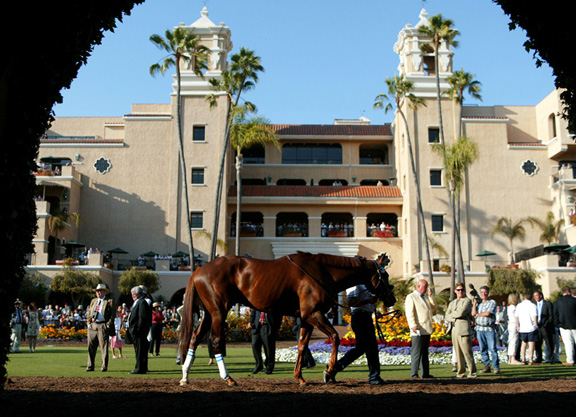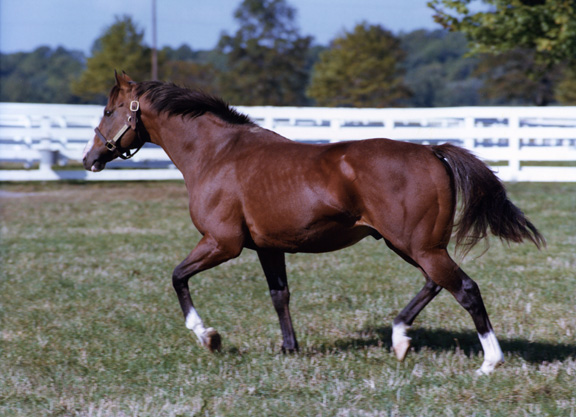Arazi (Blushing Groom {Fr}-Danseur Fabuleux, by Northern Dancer), whose five-length victory in the 1991 GI Breeders' Cup Juvenile at Churchill Downs is regarded as one of the greatest performances ever at the Breeders' Cup, has died at 32 at Stockwell Thoroughbreds in Victoria, Australia.
In a feat rarely seen nowadays, Arazi traveled to the Breeders' Cup in 1991 to take on the best American colts on the dirt. The chestnut was favoured even though he had never run on the surface and despite the presence of leading American 2-year-old Bertrando, so dominant had his campaign been in France. Second on debut at Chantilly, Arazi-bred by Buffalo Bills football team owner Ralph C. Wilson Jr. and bought by aviation magnate and racehorse owner Allen Paulson as a foal for $350,000 at Keeneland November-subsequently rolled through five consecutive victories for trainer Francois Boutin, all in stakes company including the G1 Prix Morny, G1 Prix Salamandre and G1 Grand Criterium under Gerald Mosse by a combined 11 lengths. So tall was Arazi's reputation that by the time he lined up in the starting gate at the Breeders' Cup, Sheikh Mohammed had purchased a 50% share in the horse for a reported $9-million.
Breaking from the extreme outside gate 14 under the Twin Spires and partnered by leading American rider Pat Valenzuela for the first time, Arazi was soon among the back markers in the Breeders' Cup Juvenile on the short run into the first turn. Meanwhile, Bertrando had broken like a rocket and grabbed the early advantage, allowing him to control the race uncontested through moderate fractions while Arazi languished a dozen lengths in behind with just one horse beaten. Suddenly, however, Arazi was languishing no more. Kicking into a scarcely believable gear with about a half mile to run, Arazi and Valenzuela weaved their way through the field, suddenly arriving alongside Bertrando at the quarter pole. And just as quickly as he got there, Arazi buried his rival, effectively bolting off the turn as he left Bertrando in his wake and charged down the middle of the track on the wrong lead. Arazi pulled further clear with each stride, building up an advantage of as much as 10 lengths by the time Valenzuela eased him approaching the wire, with the official margin coming in at five lengths-a record for the race at the time. Arazi became the second European-trained winner of a Breeders' Cup dirt race, the first having come just hours earlier when Sheikh Albadou (GB) (Green Desert) won the GI Breeders' Cup Sprint.
Bertrando was a further 3 1/2 lengths clear of any other rival in the Juvenile. In a cruel twist of fate, Bertrando would again be second at the Breeders' Cup two years later, once again stunned by the freak performance of a French-trained horse on the dirt, on that occasion the 133-1 Andre Fabre-trained Arcangues (Sagace {Fr}) in the GI Breeders' Cup Classic.
Arazi's feat in the Breeders' Cup Juvenile was masterfully immortalized by legendary American race caller Tom Durkin, who exclaimed as Arazi made his move: “there goes the European star Arazi, he's coming with a menacing rush to Bertrando, and now the stage is set as they move toward the top of the stretch…and Arazi runs right by him! Bertrando stunned at the inside with the move of Arazi and he's pouring it on.”
Arazi was named Europe's Horse of the Year-the only horse still to have achieved that honour as a juvenile–and America's champion 2-year-old. He is also the only horse ever to have been a finalist for Horse of the Year in America off a single North American start as a 2-year-old.
Arazi began his 3-year-old campaign with a facile five-length win in the Listed Prix Omnium going a mile on the grass at Saint-Cloud under Steve Cauthen three weeks out from the GI Kentucky Derby, prompting a press frenzy in the lead-up to America's greatest race. Another victory at Churchill Downs seemed a foregone conclusion, leaving reporters and racing fans to speculate as to what might come next. Would the French-trained colt stay in America for a crack at the Triple Crown, or would he head to England and attempt to become the first horse to win the Kentucky Derby and the Epsom Derby? Words like “mythical”, “mystical” and “extraordinary” were tossed around in the media.
In the end, however, racing displayed its uncanny ability to humble. After making a move on the turn at Churchill Downs eerily similar to what he had done six months earlier, Arazi came up empty at the top of the stretch, struggling home eighth behind longshot Lil E. Tee (At The Threshold). Arazi had had bone chips operated on between his 2- and 3-year-old campaigns, something Boutin had reportedly been against, but of course whether that was a culprit in his below-par 3-year-old campaign cannot be known. Arazi ran four more times, returning to Europe to finish fifth in the G1 St James's Palace S., third behind Arcangues in the G3 Prix du Prince d'Orange and winning the G2 Prix du Rond Point before returning to America for one more shot at recapturing the glory at the Breeders' Cup in the 1992 GI Mile. Arazi was sent off the favourite but could manage no better than 11th of 14. He was retired to stand at Darley's Dalham Hall Stud in Newmarket with nine wins from 14 starts and earnings of $1,212,351.
Arazi later embarked on a globetrotting stud career. Following his stint at Dalham Hall, the chestnut relocated to Three Chimneys Farm in Kentucky and later stood in Japan, Switzerland and Victoria, Australia. His stud career was not nearly as storied as his racing one, but he can lay claim to Congaree, winner of the GI Hollywood Gold Cup, GI Swaps S., GI Carter H. and two renewals of the GI Cigar Mile. Arazi also sired the French Group 2 winners First Magnitude (Ire) and America (Ire), and his legacy will also be felt as a broodmare sire; his daughters have produced six Group 1 winners including the G1 Dubai World Cup scorer Electrocutionist, GI Breeders' Cup Filly & Mare Turf victress Lahudood (GB) and G1 Melbourne Cup winner Americain.
Arazi had lived out his final years at Stockwell Thoroughbreds in Victoria, which said in a statement, “It is with immense sadness that Stockwell Thoroughbreds announce the passing of one of the racing world's most revered champions, Arazi, at the grand age of 32 years. The little chestnut with a crooked blaze that made him almost instantly recognisable captured the minds of racing people around the globe when in 1991 he produced one of the most memorable performances seen on a racetrack in coming from last to take out the Breeders' Cup Juvenile by an easing five-length margin. Farewell to our mate–you were indeed a superstar.”
Stockwell's Mike Becker said, “It has been an honour never lost on us to have been guardians to such a beloved horse. He had major bowel surgery as a 4-year-old and has lived with a major heart murmur for the past 16 years, but in the end it was his body that gave out, not his big heart. He will be very missed around here.”
The post Arazi Dies Age 32 appeared first on TDN | Thoroughbred Daily News | Horse Racing News, Results and Video | Thoroughbred Breeding and Auctions.



 “I'll never forget Personal Ensign's Breeders' Cup (the 1988 Distaff at Churchill Downs). It was pure heart.”
“I'll never forget Personal Ensign's Breeders' Cup (the 1988 Distaff at Churchill Downs). It was pure heart.” “I'm going to say
“I'm going to say  “Arazi in the Breeders' Cup Juvenile (1991 at Churchill Downs). He was pretty far behind on the backstretch, and when he made his move…they use this phrase a lot, 'he sprouted wings.' It was like he sprouted wings. I've never seen a horse run past horses as fast as he did. He literally ran past them like they were standing still.”
“Arazi in the Breeders' Cup Juvenile (1991 at Churchill Downs). He was pretty far behind on the backstretch, and when he made his move…they use this phrase a lot, 'he sprouted wings.' It was like he sprouted wings. I've never seen a horse run past horses as fast as he did. He literally ran past them like they were standing still.” “When Animal Kingdom was second to Wise Dan in the Breeders' Cup Mile. He had no room, the hole finally opened up, and if he had two more strides, he was a Breeders' Cup winner. That was an explosive turn of foot.”
“When Animal Kingdom was second to Wise Dan in the Breeders' Cup Mile. He had no room, the hole finally opened up, and if he had two more strides, he was a Breeders' Cup winner. That was an explosive turn of foot.” “Uni in last year's Breeders' Cup Mile. How her and Got Stormy just kicked away from the boys at the top of the lane, went neck and neck, and really dug in was just something really special to watch.”
“Uni in last year's Breeders' Cup Mile. How her and Got Stormy just kicked away from the boys at the top of the lane, went neck and neck, and really dug in was just something really special to watch.” “Midnight Lute's Breeders' Cup Sprint (2007 at Monmouth Park). He came from out of the clouds. It was a sloppy track, the horse was on the lead, and when they straightened out, he just turned it on, and he was out in front in the blink of an eye.”
“Midnight Lute's Breeders' Cup Sprint (2007 at Monmouth Park). He came from out of the clouds. It was a sloppy track, the horse was on the lead, and when they straightened out, he just turned it on, and he was out in front in the blink of an eye.”